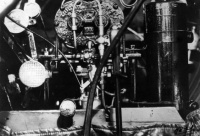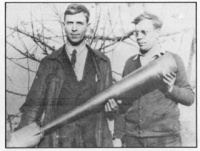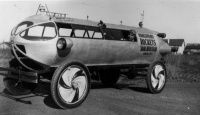Hungerford Rocket Car by Ron Miller
From The Space Library
Or, Is that a rocket in your garage or are you just happy to see me?
The 1920s were a heyday for rocketeers, who were attaching rockets to just about anything. Austrian space travel promoter Max Valier was pretty much the champ at this, creating everything from rocket-powered sleds and boats to rocket-propelled railroad cars and the first rocket airplane.
Work like Valier's led to real advancement in rocketry and public appreciation and support of space flight.
Then there were inventors like Daniel D. Hungerford and his brother Floyd S., of Elmira, NY. In 1929, they built their Solar & Interstellar Rocket Car, dubbed the "Shirley Lois Moon Girl" after Daniel's daughter. Made largely of cardboard and linoleum, a 1921 Chevy chassis, and powered by a set of gasoline-burning rocket motors, the thing must have been a fearsome sight on the back roads of rural New York. The lightweight building materials were a safety consideration. "In case of trouble," Daniel said, "I wanted to be able to kick my way out." Amazingly enough, they got the thing registered and licensed in the State of New York.
Daniel Hungerford was a glider pilot, inventor, lecturer and promoter of some pretty interesting ideas, such as the one he and his brother had of flying a rocket to the moon. He and brother Floyd operated a shop where they repaired cars and aircraft. They had been fascinated by aviation even before the Wright Brother's first flight. Probably no surprise since Elmira was then—-as it still is today—-a hotbed of glider enthusiasm.
The Hungerfords were inspired by the successful rocket car experiments of Valier, which were making news around the world. "...we couldn't see why it couldn't be tried here," Daniel said, "so we decided to build a working model."
Their plan was to build a prototype and then a second model if that worked. The idea was to go into business building rocket cars in a big way. "We never drew and plans or diagrams for this," he said, "because we never got as far as the second prototype. We simply spent all our time trying to promote the car we had." Which included making exhibition appearances at fairs and airports. But if they had gone into full-scale manufacturing, they would have produced a rocket car about the size of a Buick, "with the rocket exhaust pipe or pipes running under the frame of the body..."
 Looking aft, toward the rocket motors
Looking aft, toward the rocket motors
 The fuel compressor and other controls
The fuel compressor and other controls
An ordinary gasoline engine was used to bring the car up to speed, after which the rocket motor would take over. In one of the rocket car's first tests, it achieved a speed of 70 mph with a 20-feet sheet of flame trailing behind it. It got 2 miles to the gallon.
 The brothers had very high hopes
The brothers had very high hopes
"Then we considered trying to build a rocket ship which might reach the moon, but we never got any further on this than having a picture painted by a sign painter we knew."
Amazingly enough, the Rocket Car survived and is on exhibit at the New York State Museum in Albany. It was rescued in the 1960s by Ralph Hodge and Keith Marvin from the back yard of the inventor, who had retired it in 1932 after failing to generate any interest from sponsors or backers (Hungerford died in Elmira in 1968). They had it restored and placed in the museum, where it remains to this day.




